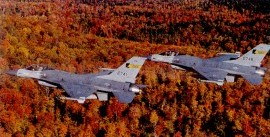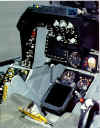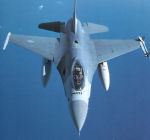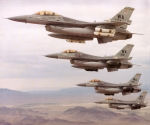 The F-16 evolved from a 1972 USAF Lightweight Fighter (LWF) prototype program which sought a small, lightweight,
low cost, air superiority day fighter designed for high performance and ease of
maintenance. The YF-16 was selected the winner, over the Northrop YF-17, after the LWF
fly-off competition was completed. The basic YF-17 design was used as the basis for the US
Navy F-18.
The F-16 evolved from a 1972 USAF Lightweight Fighter (LWF) prototype program which sought a small, lightweight,
low cost, air superiority day fighter designed for high performance and ease of
maintenance. The YF-16 was selected the winner, over the Northrop YF-17, after the LWF
fly-off competition was completed. The basic YF-17 design was used as the basis for the US
Navy F-18.
The F-16 achieved combat-ready status in October 1980. Many foreign nations, including Belgium, Denmark, Norway, Turkey, Egypt and Israel, have purchased the F-16. More about the F-16.
TYPE
F-16AF-16B
F-16C
F-16D
F-16N
TF-16N
F-16XL
Number built/Converted
1432312
1823
404
22
4
2 (cv)
Remarks
670 to USAF122 to USAF
1,222 to USAF
206 to USAF
US Navy F-16C
US Navy F-16D
Cranked Arrow wing
SPECIFICATION
Wing: span 31 ft 0 in
(9.45m) without tip-mounted AAMs and 32 ft 9.75 (10.00 m) with tip mounted AAMs; aspect
ratio 3.09; area 300.00 sq ft (28.87 mē)
Fuselage and tail:
length 49 ft 4 in (15.03 m):; height 16 ft 8.5 in (5.09 m); tailplane span 18 ft 3.75 in
(5.58 m); wheel track 7 ft 9 in (2.36 m); wheel base 13 ft 1.5 in (4.00 m)
Powerplant: one
Pratt & Whitney F100-P-220 turbofan rated at 23,450 lb st (104.31 kN) with
afterburning or one General Electric F110-GE-100 turbofan rated at 27,600 lb st (122.77
kN) with afterburning
Weights: empty
19,100 lb (8663 kg) with F110 turbofan or 18,335 lb (8316 kg) with F100 turbofan; typical
combat take-off 21,585 lb (9791 kg); maximum take-off 25,071 lb (11372 kg) for an
air-to-air mission without drop tanks or 42,300 lb (19187 kg) with maximum external load
Fuel and load:
internal fuel 6,972 lb (3162 kg); external fuel up to 6,760 lb (3066 kg) in three 300-,
370-, 450- and 600-US gal (1136-, 1400-, 1703- and 2271-litre) drop tanks; maximum
ordnance 15,200 lb (6894 kg)
Speed: maximum
level speed 'clean' at 40,000 ft (12190 m) more than 1,146 kt (1,320 mph; 2124 km/h) and
at sea level 795 kt (915 mph; 1472 km/h)
Range: ferry range
more than 2,100 nm (2,418 miles, 3891 km) with drop tanks; combat radius 295 nm (340
miles; 547 km) on a hi-lo-hi mission with six 454 kg (1,000 lb) bombs
PERFORMANCE
maximum rate of climb at sea level more than 50,000 ft (15240m) per minute; service ceiling more than 50,000 ft (15240 m); typical take-off run 2,500 ft (762 m) at MTOW; typical landing run 2,500 ft (762 m) at normal landing weight
g limits: +9












